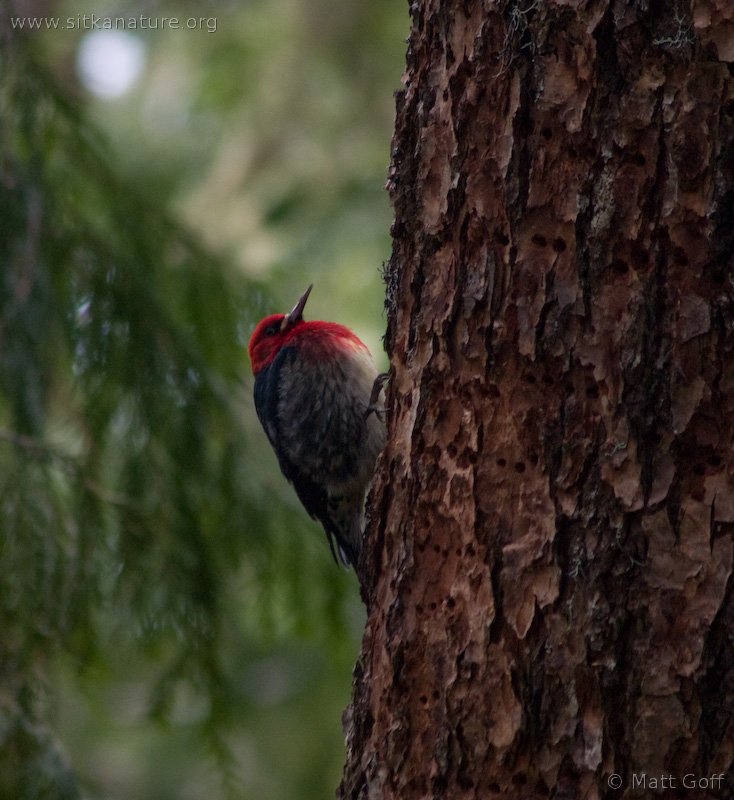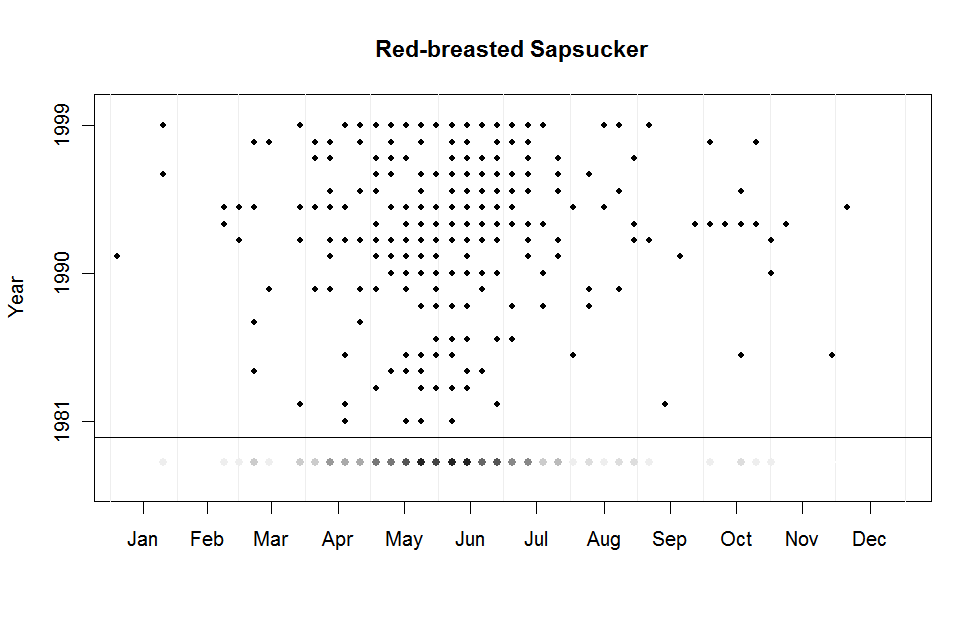Red-breasted Sapsucker in December
Fairly easy to find around Sitka during spring and summer working their sap wells, Red-breasted Sapsucker abundance seems to drop in the fall and they are rarely reported from November through February along the road system. Most times when sapsuckers are seen, it is during periods with extended below freezing temperatures. At such times, they are most often found in forests with good south facing exposures (Totem Park being a good example). In the absence of any observations, it would be easy to imagine that these birds migrate south for warmer locales, and I suspect that is true for most of the birds that breed in the area. However, given the pattern of winter sightings over the years, it seems that some sapsuckers do spend the winter here, though apparently hiding somewhere they are not often noticed except during cold snaps.
I enjoy hiking the hills and mountains around Sitka, but over the past several years I have made it up relatively high only once or twice per winter. Somewhat surprisingly, on several of these hikes I have seen a sapsucker at moderate elevations (I’m guessing between 1000ft and 2000ft). Although this constitutes only a handful of observations, the fact that it occurred on a relatively high proportion of opportunities suggested that sapsuckers may be hanging out at mid-elevations throughout much of the winter, at least around Sitka.
Although my experiences finding sapsuckers led me to believe that they were likely to be spending winters in mid-elevation forests, I was puzzled because I could not figure out why they would prefer this habitat over lower elevations where conditions are less harsh. Adding to the mystery is that I do not remember seeing sapsuckers at mid-elevations much, if at all, during the spring and summer. I associate them almost exclusively with low elevations in forests near shorelines or valley bottoms, generally below <500 feet, and mostly closer to sea level than 500ft. A couple of weeks ago on my annual trek of Mt. Verstovia for the Christmas Bird Count, I once again found a Red-breasted Sapsucker working a tree at about 1500 feet or so. I watched the bird tapping at the well on the trunk of a moderate-sized Sitka Spruce, and for some reason I thought I remembered reading or hearing that getting sap to make maple syrup works best when nights are below freezing and days are above. I could not remember where I got this information (or if I had confused it somehow), so when I got home I took a look on-line. According to wikipedia’s article on maple syrup production, “Freezing nights and warm days are needed to induce sap flows. The change in temperature from above to below freezing causes water uptake from the soil, and temperatures above freezing cause a stem pressure to develop, which, along with gravity, causes sap to flow out of tapholes or other wounds in the stem or branches.”
The way I read this, sap flow seems to be a matter of physics more than anything special about the maple trees (though the same cannot be said of sugar content!). Freezing nights and warm days result in greater sap flow than consistently warm (or cold temperatures). This suggests a plausible reason that sapsuckers would prefer the mid-elevation forests over the warmer lowlands – at those middle elevations, temperatures are more often below freezing at night while warming sufficiently during the day to provide a more abundant food source for the birds.
It should not be too hard to test the temperature and sap-flow part of this hypothesis, a handful of ibuttons and a tap or two to collect sap ought to do it. (It would also be interesting to know whether the winter birds are individuals who also breed here, though that would be more challenging to determine, I suspect). Perhaps one of these winters I’ll give it a try, but in the meantime this is the best explanation I’ve been able to come up with for the somewhat unexpected behavior of Sitka area Red-breasted Sapsuckers in winter.


Matt,
your site is very interresting!
I enjoy discovering news things, and observations!
thank you for taking so much time to share them!
Julien.
Thanks Julien! It was nice to meet you, and I look forward to seeing you again on your next visit.